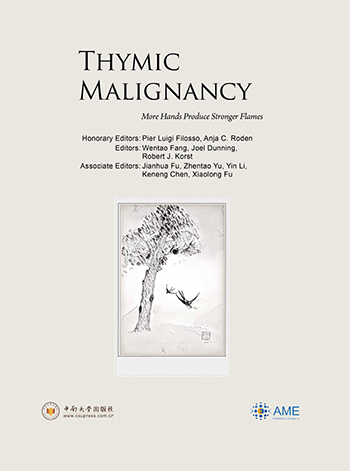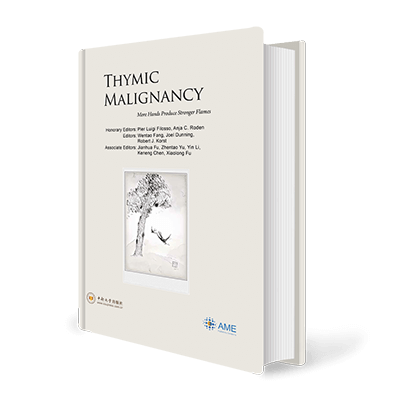31 CT staging and preoperative assessment of resectability for thymic epithelial tumors
Yan Shen, Zhitao Gu, Jianding Ye, Teng Mao, Wentao Fang, Wenhu Chen
41 Only when all contribute their firewood can they build up a big fire
Marcelo F. Benveniste, Edith M. Marom
44 Comparison of the Masaoka-Koga staging and the International Association for the Study of Lung Cancer/the International Thymic Malignancies Interest Group proposal for the TNM staging systems based on the Chinese Alliance for Research in Thymomas retrospective database
Guanghui Liang, Zhitao Gu, Yin Li, Jianhua Fu, Yi Shen, Yucheng Wei, Lijie Tan, Peng Zhang, Yongtao Han, Chun Chen, Renquan Zhang, Keneng Chen, Hezhong Chen, Yongyu Liu, Youbing Cui, Yun Wang, Liewen Pang, Zhentao Yu, Xinming Zhou, Yangchun Liu, Yuan Liu, Wentao Fang; Members of the Chinese Alliance for Research in Thymomas
55 The International Association for the Study of Lung Cancer/the International Thymic Malignancies Interest Group proposal for the TNM staging systems for thymic epithelial tumors and large-scale retrospective data
Kazuya Kondo
58 The enlightenments from ITMIG Consensus on WHO histological classi cation of thymoma and thymic carcinoma: re ned de nitions, histological criteria, and reporting
Jie Wu, Wentao Fang, Gang Chen
64 Clinicopathological analysis of 241 thymic epithelial tumors—experience in the Shanghai Chest Hospital from 1997–2004
Lei Zhu, Jie Zhang, Alexander Marx, Christel Weiss, Wentao Fang
73 Thymic epithelial tumors in a worldwide perspective: lessons from observational studies
Mirella Marino, Tommaso Salvitti, Edoardo Pescarmona, Giovannella Palmieri
78 Pretreatment biopsy for histological diagnosis and induction therapy in thymic tumors
Jie Yue, Zhitao Gu, Zhentao Yu, Hongdian Zhang, Zhao Ma, Yuan Liu, Wentao Fang; Members of the Chinese Alliance for Research in Thymomas
87 Pretreatment biopsy for thymic epithelial tumors—does histology subtype matter for treatment strategy?
Sukhmani K. Padda, Marlies Keijzers, Heather A. Wakelee
93 Preoperative induction therapy for locally advanced thymic tumors: a retrospective analysis using the ChART database
Yucheng Wei, Zhitao Gu, Yi Shen, Jianhua Fu, Liejie Tan, Peng Zhang, Yongtao Han, Chun Chen, Renquan Zhang, Yin Li, Keneng Chen, Hezhong Chen, Yongyu Liu, Youbing Cui, Yun Wang, Liewen Pang, Zhentao Yu, Xinming Zhou, Yangchun Liu, Yuan Liu, Wentao Fang; Members of the Chinese Alliance for Research in Thymomas
101 Multimodality therapy for locally-advanced thymic epithelial tumors: where are we now?
Pier Luigi Filosso, Francesco Guerrera, Alberto Sandri, Enrico Ruf ni
104 The role of postoperative radiotherapy for stage I/II/III thymic tumor—results of the ChART retrospective database
Qianwen Liu, Zhitao Gu, Fu Yang, Jianhua Fu, Yi Shen, Yucheng Wei, Lijie Tan, Peng Zhang, Yongtao Han, Chun Chen, Renquan Zhang, Yin Li, Keneng Chen, Hezhong Chen, Yongyu Liu, Youbing Cui, Yun Wang, Liewen Pang, Zhentao Yu, Xinming Zhou, Yangchun Liu, Jin Xiang, Yuan Liu, Wentao Fang; Members of the Chinese Alliance for Research in Thymomas
113 The application of postoperative chemotherapy in thymic tumors and its prognostic effect
Ke Ma, Zhitao Gu, Yongtao Han, Jianhua Fu, Yi Shen, Yucheng Wei, Lijie Tan, Peng Zhang, Chun Chen, Renquan Zhang, Yin Li, Keneng Chen, Hezhong Chen, Yongyu Liu, Youbing Cui, Yun Wang, Liewen Pang, Zhentao Yu, Xinming Zhou, Yangchun Liu, Yuan Liu, Wentao Fang; Members of the Chinese Alliance for Research in Thymomas
122 How large databases may impact clinical practices for rare tumors—postoperative chemotherapy in thymic malignancies
Nicolas Girard, Claire Merveilleux du Vignaux
124 Outcome of nonsurgical treatment for locally advanced thymic tumors
Changlu Wang, Lanting Gao, Changxing Lv, Lei Zhu, Wentao Fang
130 Non-surgical treatment of locally advanced thymic epithelial tumors—a need for multicenter trials
Anja C. Roden
134 Postoperative survival for patients with thymoma complicating myasthenia gravis—preliminary retrospective results of the ChART database
Fangrui Wang, Liewen Pang, Jianhua Fu, Yi Shen, Yucheng Wei, Lijie Tan, Peng Zhang, Yongtao Han, Chun Chen, Renquan Zhang, Yin Li, Keneng Chen, Hezhong Chen, Yongyu Liu, Youbing Cui, Yun Wang, Zhentao Yu, Xinming Zhou, Yangchun Liu, Yuan Liu, Zhitao Gu, Wentao Fang; Members of the Chinese Alliance for Research in Thymomas
141 Editorial on “Postoperative survival for patients with thymoma complicating myasthenia gravis— preliminary retrospective results of the ChART database”
Alper Toker, Berker Ozkan
Surgical Therapies for Thymic Malignancies
143 Thymectomy versus tumor resection for early-stage thymic malignancies: a Chinese Alliance for Research in Thymomas retrospective database analysis
Zhitao Gu, Jianhua Fu, Yi Shen, Yucheng Wei, Lijie Tan, Peng Zhang, Yongtao Han, Chun Chen, Renquan Zhang, Yin Li, Keneng Chen, Hezhong Chen, Yongyu Liu, Youbing Cui, Yun Wang, Liewen Pang, Zhentao Yu, Xinming Zhou, Yangchun Liu, Yuan Liu, Wentao Fang; Members of the Chinese Alliance for Research in Thymomas
150 Thymomectomy in early stage thymomas—case closed?
Marlies Keijzers, Jos G. Maessen
153 Standardized de nitions and policies of minimally invasive thymoma resection
Alper Toker
158 Video-assisted thoracoscopic surgery versus open thymectomy for thymoma: a systematic review
Ashleigh Xie, Richard Tjahjono, Kevin Phan, Tristan D. Yan
172 Minimally invasive versus open thymectomy: a systematic review of surgical techniques, patient demographics, and perioperative outcomes
Nicholas R. Hess, Inderpal S. Sarkaria, Arjun Pennathur, Ryan M. Levy, Neil A. Christie, James D. Luketich
181 Endoscopic thymectomy: a neurologist’s perspective
Roberta Ricciardi, Franca Mel , Michelangelo Maestri, Anna De Rosa, Afroditi Petsa, Marco Lucchi, Alfredo Mussi
188 Perioperative outcomes and long-term survival in clinically early-stage thymic malignancies: video- assisted thoracoscopic thymectomy versus open approaches
Hao Wang, Zhitao Gu, Jianyong Ding, Lijie Tan, Jianhua Fu, Yi Shen, Yucheng Wei, Peng Zhang, Yongtao Han, Chun Chen, Renquan Zhang, Yin Li, Keneng Chen, Hezhong Chen, Yongyu Liu, Youbing Cui, Yun Wang, Liewen Pang, Zhentao Yu, Xinming Zhou, Yangchun Liu, Yuan Liu, Wentao Fang; Members of the Chinese Alliance for Research in Thymomas
195 Early stage thymoma: is VATS the new standard of care?
Hasan Fevzi Batirel
198 Minimally invasive thymectomy: the Mayo Clinic experience
Phillip G. Rowse, Anja C. Roden, Frank M. Corl, Mark S. Allen, Stephen D. Cassivi, Francis C. Nichols, K. Robert Shen, Dennis A. Wigle, Shanda H. Blackmon
206 Multi-institutional European experience of robotic thymectomy for thymoma
Giuseppe Marulli, Jos Maessen, Franca Mel , Thomas A. Schmid, Marlies Keijzers, Olivia Fanucchi, Florian Augustin, Giovanni M. Comacchio, Alfredo Mussi, Monique Hochstenbag, Federico Rea
214 Subxiphoid uniportal thoracoscopic extended thymectomy
Liang Wu, Lei Lin, Ming Liu, Lei Jiang, Gening Jiang
217 Subxiphoid and subcostal arch thoracoscopic extended thymectomy: a safe and feasible minimally invasive procedure for selective stage III thymomas
Jinbo Zhao, Juzheng Wang, Zhengwei Zhao, Yong Han, Lijun Huang, Xiaofei Li, Qiang Lu, Yongan Zhou
224 Thymectomy via a subxiphoid approach: single-port and robot-assisted
Takashi Suda, Shinji Kaneda, Ayumi Hachimaru, Daisuke Tochii, Ryo Maeda, Sachiko Tochii, Yasushi Takagi
231 Left- and right-sided video-assisted thoracoscopic thymectomy exhibit similar effects on myasthenia gravis
Xuan Xie, Xiangfeng Gan, Baishen Chen, Zhuojian Shen, Minghui Wang, Huizhong Zhang, Xia Xu, Ju Chen
240 Video assisted thoracic surgery (VATS) for recurrent thymoma
Giuseppe Marulli, Giovanni Maria Comacchio, Federico Rea




